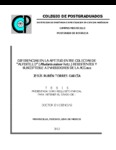| dc.description.abstract | Las malezas compiten intensamente con los cultivos, por lo cual, los agricultores
emplean prácticas de control (manual, mecánico y químico) para eliminarlas. Los
herbicidas ejercen una presión de selección extrema (99.99%) sobre las poblaciones.
Como consecuencia, en unas pocas generaciones se observan individuos resistentes
(R) en las poblaciones de maleza. La resistencia a herbicidas es un proceso evolutivo
causado por cambios metabólicos o genéticos. En algunas especies la resistencia va
acompañada de una disminución en la aptitud competitiva (fitness). Esto puede
ocasionar que las plantas resistentes sean desplazadas cuando el factor de selección
se retire de las poblaciones. Phalaris minor (Poaceae) es una maleza que evolucionó
hacia la adquisición de resistencia a herbicidas inhibidores de la síntesis de lípidos en el
Bajío Mexicano. Aún se desconoce si esta especie presenta diferencias en la aptitud
entre individuos susceptibles (S) y R. El objetivo del presente estudio fue determinar las
diferencias en la aptitud entre individuos S y R de P. minor provenientes de la región del
Bajío. Se analizó la genética de las poblaciones (secuenciación de genes: código de
barras y ACCasa).Se realizaron experimentos en semillas (tamaño del embrión,
latencia, germinación, vigor), ciclo biológico (fenología, acumulación de biomasa y
fecundidad), competencia por luz (dinámica de la cobertura del dosel bajo emergencia
natural y simultanea, productividad relativa, agresividad e intensidad de competencia).
El análisis de secuencias mostró que las colectas no presentan mutaciones en la región
del código de barras, pero sí en el gen de la ACCasa. Las mutaciones que causan la
resistencia se presentaron en diferentes posiciones dentro del gen estudiado, por lo que
se establece que las poblaciones evolucionaron independientemente hacia la
resistencia. En las semillas el tamaño del embrión tuvo una reducción hasta del 50% en
individuos R, esto ocasionó que requirieran un mayor número de días para superar la
latencia primaria, y tuvieran un porcentaje y velocidad de germinación menor. En el ciclo
biológico se encontraron diferencias en la fenología, acumulación de biomasa y
producción de semillas. Las colectas Col 4 y Gto fueron precoces, con poca
acumulación de biomasa; mientras que Col 7 y Jal fueron de lento crecimiento, pero de
mayor acumulación de biomasa, en todas se observó una fecundidad menor en
comparación con el S. En la competencia por la luz, el retraso en la emergencia de las
colectas R, ocasionó que tuvieran una menor proyección de la cobertura del dosel con
respecto al S. Cuando la emergencia fue simultánea, no se observaron diferencias en la
cobertura del dosel lo que incrementó la intensidad de competencia. La reducción en la
aptitud encontrada en las colectas R podría ser una explicación razonable del bajo éxito
de los individuos resistentes bajo condiciones no selectivas, lo que podría causar el
retorno a las poblaciones susceptibles cuando se retire el factor de selección. _______________ FITNESS DIFFERENCES BETWEEN COLLECTIONS OF "ALPISTILLO" (Phalaris minor Retz.) RESISTANT AND SUSCEPTIBLE TO INHIBITORS OF ACCase. ABSTRACT: Weeds are plants that compete intensively with crops, reducing the yield, therefore,
farmers use practices (manual, mechanical and chemical) to eliminate them. However,
herbicides exert extreme selection pressure (99.99%) on weed populations. Like a
consecuence of the selection pressure, in a few generations are observed individuals
resistant (R) in weed populations. Herbicide resistance is an evolutionary process
caused by metabolic or genetic changes. However, in some species the evolution of
resistance is accompanied by a decrease in the competitive fitness of individuals
(fitness). This penality can cause that resistant plants are displaced when the selection
factor is retired on populations. Phalaris minor (Poaceae) is a weed that evolved into the
acquisition of resistance to inhibitors lipid synthesis herbicides in the Bajio Mexican. It
remains unclear whether this species differs in fitness during the stages of their life cycle
between susceptible individuals (S) and resistant. Therefore, the objective of this study
was to determine the differences in fitness between individuals S and R of P. minor from
the Bajio region. We analyzed the population genetics (sequencing chloroplast genes:
barcode and resistance to inhibitor lipid synthesis herbicides). Experiments were
conducted on seeds (embryo size, dormancy, germination, vigor), life cycle (phenology,
biomass accumulation and fecundity), competition for light (dynamic of canopy cover
under simultaneous and natural emergence, relative productivity, aggressivity and
intensity of competition). The nucleotide sequence analysis showed that no mutations
are presents in the studied collects in the region of the barcode, but them are presents
in the reported gene for resistance to inhibitors of lipid. Mutations causing the resistance
presented at various positions within the studied gene, therefore establishing that
populations toward resistance evolved independently. In seed embryo size was reduced
to 50% resistant individuals, this caused requiring a greater number of days to overcome
the latency primary and had a lower germination percentage and speed. In the biological
cycle differences in phenology, biomass accumulation and seed production. The
collections Gto and Col 4 were early, with little accumulation of biomass, while Col 7
and Jal were of slow growth, but higher biomass accumulation, all collections R had
lower fertility compared to S. In the study of the collections under competition for light,
the delay in the emergence of R collections, resulted in a lower projection of the canopy
cover with respect to S. When the emergence was simultaneous, no differences in
canopy cover, which increased the intensity of competition. The reduction in fitness
found in the collections R could be a reasonable explanation for the low success of
resistant individuals under nonselective conditions, which could cause a return to
susceptible populations when removing the selection factor. | en_US |


